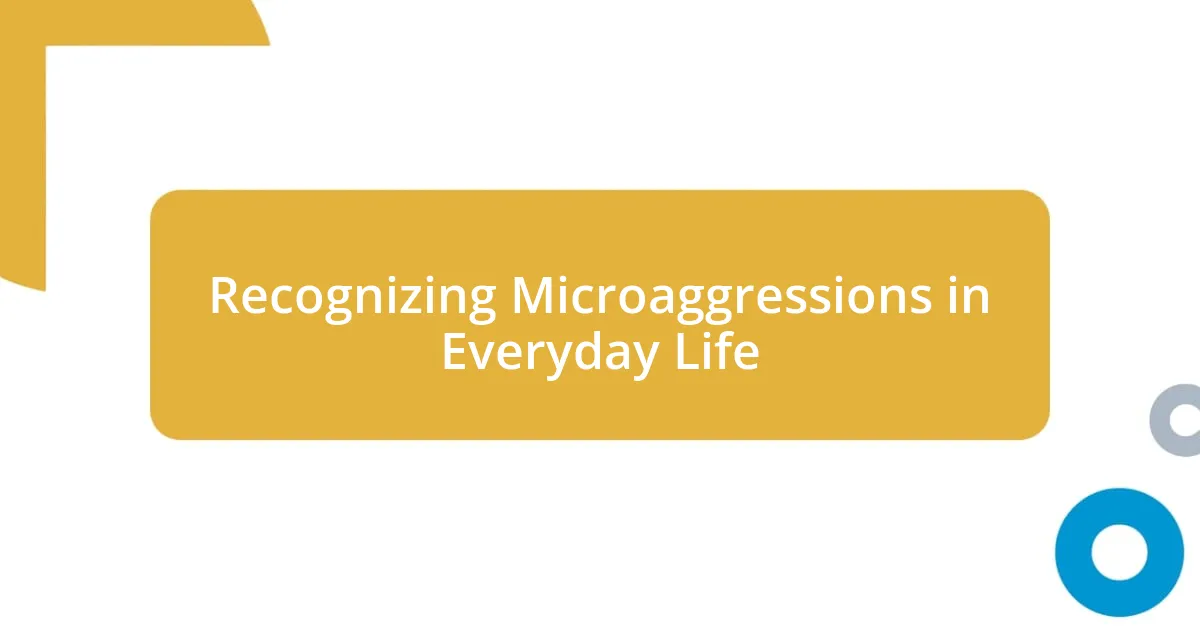Key takeaways:
- Racial microaggressions are subtle, often unintentional comments/actions that express prejudice and can deeply impact mental well-being and sense of belonging.
- Microaggressions fall into three categories: microassaults (overt attacks), microinsults (disguised as compliments), and microinvalidations (negating experiences).
- Addressing microaggressions involves proactive conversations, self-reflection, and education to foster understanding and challenge stereotypes.
- Accessing educational resources and community support is crucial for confronting microaggressions and promoting meaningful dialogue around race and identity.

Understanding Racial Microaggressions
Racial microaggressions are subtle, often unintentional, comments or actions that perpetuate stereotypes or express prejudice. I recall a day at work when a colleague, trying to compliment my hair, said, “It looks so… different.” The word “different” hung in the air, making me wonder if that was code for something more. Have you ever experienced that awkward pause where words fall flat, leaving you questioning their true intent?
These encounters, while seemingly minor, reveal deeper societal attitudes and can accumulate over time, impacting mental well-being. I often find myself reflecting on how these microaggressions chip away at one’s sense of belonging. When someone asks where I’m really from, it makes me wonder why my appearance seems to dictate my narrative. Isn’t it frustrating to feel that your identity is constantly being scrutinized?
Understanding microaggressions requires us to recognize their emotional weight. I’ve felt everything from confusion to anger during these moments, and they often leave me questioning my place in various spaces. It’s important to see these not just as isolated incidents but as a pattern that contributes to a larger discussion on race and identity. Have you ever noticed how such encounters linger in your mind, reshaping your self-perception?

Types of Racial Microaggressions
Racial microaggressions can generally fall into three distinct categories: microassaults, microinsults, and microinvalidations. Each type carries its own particular nuances and implications. In my experience, a microassault might manifest as a derogatory comment or an overtly racist joke, functioning as a blatant attack on racial identity. I remember overhearing a group at a gathering laughing at an outdated stereotype. It felt jarring, as if they were shooting arrows aimed directly at my culture.
Microinsults, on the other hand, often disguise themselves as compliments but carry a weight of condescension. I recall someone once saying, “You speak English so well,” implying that my racial background shouldn’t include fluency in the language. It was intended as praise, but it felt like a reminder that my ethnicity seemed to overshadow my intellect. Such comments can significantly affect how we perceive our capabilities and worth in social situations.
Lastly, microinvalidations dismiss or negate the lived experiences of individuals from marginalized groups. For example, when someone says, “I’m not racist; I have friends who are Black,” it completely invalidates the very real experiences of racism I’ve faced. It leaves me questioning their understanding of race while simultaneously compartmentalizing my identity into a mere statistic. It’s crucial that we recognize these types of microaggressions and learn to respond to them in ways that foster understanding and empathy.
| Type of Microaggression | Description |
|---|---|
| Microassault | Overt, intentional, and explicit attacks on an individual’s identity, often disguised as humor. |
| Microinsult | Subtle comments that convey disrespect and can undermine an individual’s self-worth, often under the guise of compliments. |
| Microinvalidation | Comments that dismiss or negate the experiences and feelings of marginalized individuals, often reflecting ignorance or misunderstanding. |

Personal Experiences with Microaggressions
There are moments when microaggressions hit you like a surprise rain shower—unexpected and unsettling. I vividly remember a time at a coffee shop when the barista looked puzzled while taking my order. “Are you sure you want that choice? It’s a bit, you know, spicy.” The implication was clear: my skin color had already set the stage for where I ‘should’ be comfortable, and this nuanced jab left me feeling both annoyed and somewhat diminished. It’s astonishing how a few seemingly inconsequential words can shake your confidence in your identity.
Reflecting on these instances, I realize the emotional toll they take, often altering the way I interact in social settings.
- Questioning my choices: After that coffee shop incident, I found myself contemplating whether I should change my preferences to fit someone else’s perception.
- Lingering doubts: Each microaggression adds layers of doubt, making me wonder if I’m perceived first through the lens of race rather than my individuality.
- Isolation in a crowd: Even when surrounded by friends, these comments can create a silent distance, making me feel as though they don’t fully comprehend my experiences.
Navigating through these interactions is exhausting but necessary if we want to foster genuine understanding and connection. I think it’s vital for each of us to remain mindful of our words and their potential impact, fostering a culture that celebrates rather than stereotypes.

The Impact of Microaggressions
Microaggressions can subtly erode one’s self-esteem and sense of belonging. I remember a workplace scenario where a colleague casually remarked, “You must be really good at multicultural events!” It felt like a backhanded compliment, as if my value hinged solely on my ethnicity rather than my skills. Such comments made me wonder: Do they really see me for who I am, or just the color of my skin?
Every encounter with microaggressions layers on an unseen weight. Some days, I find myself exhausted by the effort it takes to navigate conversations without letting those jabs dictate my mood or interactions. In a group setting, I might smile politely, but inside, questions swirl: Am I just a token in this space? When you constantly have to reassess the implications behind seemingly innocent words, the emotional labor can be taxing.
Over time, I’ve learned that addressing microaggressions isn’t just about calling out inappropriate comments; it’s also about reclaiming my narrative. Reflecting on each experience has taught me to stand firm in my identity and remind others—and myself—that I’m more than just a stereotype. Helping people understand the impact of their words can foster a richer dialogue and perhaps challenge the very perceptions that give rise to these microaggressions in the first place.

Recognizing Microaggressions in Everyday Life
Recognizing microaggressions in everyday life often requires a heightened awareness of the subtleties in our interactions. For instance, I recall a gathering where a well-meaning friend commented, “You’re really articulate for someone from your background.” At that moment, I felt an uncomfortable mix of flattery and frustration—why did my eloquence have to be a surprise? It’s moments like these that reveal how deeply ingrained assumptions can subtly shape how we perceive one another.
Sometimes, it’s the seemingly harmless questions that can carry a heavy weight. I was once asked, “Where are you really from?” after confidently sharing my hometown. This simple inquiry felt like a sting, as if my identity could only be validated by tracing it back to somewhere else. Questions like these leave me pondering: why is my heritage the lens through which I am viewed? They encourage reflection on whether I’m perceived through a narrow filter instead of as a multi-dimensional individual.
Everyday interactions can become a minefield of microaggressions, and recognizing them is essential for fostering genuine connections. I’ve found that becoming more aware allows me to differentiate between genuine curiosity and assumptions based on stereotypes. This attentiveness not only empowers me to respond more effectively but also invites others into a conversation about the impact of their words. Have you ever felt that subtle shift in a conversation that made you question your place within it? I know I have, and it has pushed me to engage more deeply in discussions about race and identity.

Strategies for Addressing Microaggressions
Addressing microaggressions can be daunting, but I’ve found that adopting a proactive mindset is key. For instance, during a team meeting, a colleague mentioned, “You’re so lucky to have such a diverse background.” Instead of letting the comment slide, I chose to respond thoughtfully. I replied, “I appreciate the sentiment, but it’s essential to recognize that diversity isn’t just a stroke of luck; it’s rooted in our experiences and contributions.” This kind of engagement can help shift perspectives and encourage deeper understanding.
Another strategy I often use is self-reflection. After an uncomfortable incident, I take a moment to evaluate how it made me feel and why. This reflection not only validates my emotions but also prepares me for future encounters. It’s like mentally gearing up for a match; the more you understand your feelings, the better equipped you are to articulate them. I’ve discovered that sharing these insights with trusted friends can help create a supportive network where I can practice how to respond constructively.
Finally, I firmly believe in the power of education. I once hosted a small workshop aimed at navigating conversations around race, where we discussed the nuances of microaggressions. It was enlightening to witness baffled expressions shift to understanding as participants grasped how their words could carry unintended weight. Isn’t it fascinating how dialogue can spark change? We learned together that by raising awareness, we’re not just addressing individual comments—we’re paving the way for more inclusive and empathetic interactions in our communities.

Support and Resources for Education
In my journey to understand and confront racial microaggressions, accessing educational resources has proved invaluable. I remember attending a community seminar on race and identity, where I was taken aback by the personal stories shared by others. Hearing their experiences made me realize that I wasn’t alone; there’s a community of individuals eager to learn and grow together. Isn’t it powerful when we can lean on one another for support and insight?
I’ve also found online platforms to be treasure troves of information. Websites that curate articles, podcasts, and videos on racial issues have broadened my understanding immensely. Being able to dive into these resources when I have the time to really reflect has been enlightening. Have you ever stumbled upon a video or article that made you rethink a perspective you held? That’s exactly what happened for me when I discovered a series of interviews with educators discussing their experiences with microaggressions in the classroom.
Moreover, I encourage engaging with local libraries or universities that often host workshops or discussions focused on these topics. I recently joined a book club centered around discussions of race, and it has become a space where I feel safe to express my thoughts while learning from others. These platforms not only provide education but also nurture dialogue that fosters understanding and empathy. Don’t you feel empowered when you can share in meaningful conversations around challenging topics? It’s a reminder that education is not just about facts; it’s about building connections.













